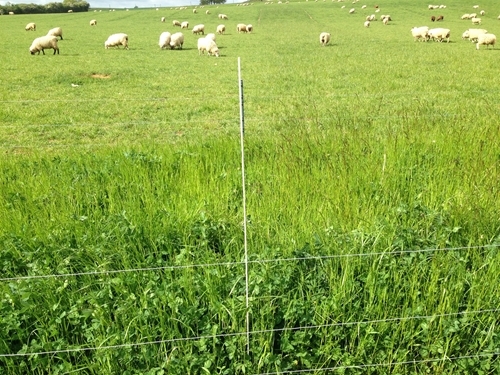Introducing grass leys into arable rotations has the potential to improve soil structure and organic matter. This has benefits to the arable rotation, but can also increase water infiltration rates during storms, with resulting benefits in terms of flood risk management at the catchment scale. Reduced runoff from agricultural catchments can also result in improved water quality and aquatic ecology.
In one of our replicated plot experiments in the EU funded SoilCare project, we selected five modern deep-rooting agricultural grass cultivars as being the most likely to create pathways for water to reach deep into the soil profile, rather than running off the surface. Each cultivar was represented as a 50% component of an otherwise standard ryegrass and clover mix, with control plots comprising this standard mixture alone. The whole area was grazed by sheep and cut for silage following standard practice, but in years three and four of the experiment, we fenced off a three metre wide strip which was ungrazed and uncut.

We found that water infiltration rates were highest for the Festulolium cultivar, 'Fojtan' and the cocksfoot cultivar, 'Donata' in Year 1 of the experiment, but this was not repeated in subsequent years. A detailed assessment of root volume through the soil profile in Year 3 revealed that Fojtan root biomass was nearly four times higher than the standard ryegrass mixture at 70cm, but this was the case only where there was no grazing or cutting. In the adjacent cut and grazed areas, the standard ryegrass mixture had higher biomass at 70cm, but this was only half that of the ungrazed Fojtan. In Year 4, when root volume for all five cultivars was measured, four of them had higher values in ungrazed areas than grazed areas, but this difference was not statistically significant.
Soil compaction at 10cm was significantly higher in the grazed and cut areas than the fenced off portions of the strips, and within the fenced off area there was a 40% difference in sward volume between the areas with highest and lowest compaction. As root volume reflects above ground biomass, compaction is likely to be limiting water infiltration both directly, and by limiting root growth.
The results suggest that while some deep-rooting grass cultivars have the potential to contribute to landscape scale flood risk management, their capacity to do so may be limited by soil compaction associated with grazing livestock and harvesting of silage. As autumns become increasingly wet, grazing during this period can be particularly damaging to soil structure. For objectives such as flood risk management and water quality improvement to be met, a balance may need to be struck between the management adopted to meet the objectives of farm businesses and those of wider society. Economic incentives within the new Sustainable Farming Initiative to increase sward height and manage stocking densities to minimise poaching and soil compaction may enable farmers to meet both objectives if the right balance can be struck between payments and practice on different soil types.
There are more details of our research in: Stoate, C., Bussell, J. and Fox, G. 2021. Potential of deep-rooting agricultural grass cultivars for increasing water infiltration and soil organic carbon. In: Intercropping for Sustainability: Research developments and their application. Aspects of Applied Biology 146.